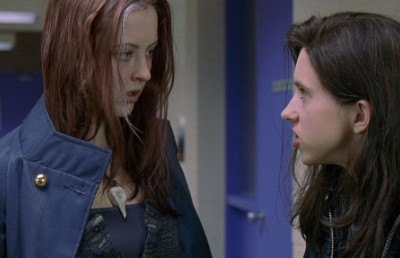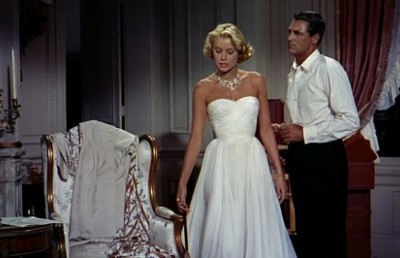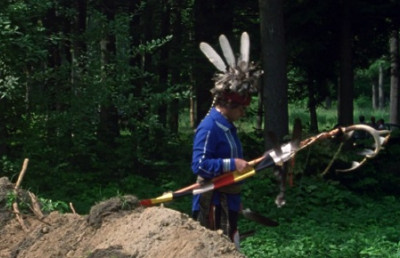The Road, Red and White (and Blue): Canadian Identity in Bruce McDonald’s Road Trilogy

Pierre Elliott Trudeau’s term as Prime Minister is largely said to be the most poignant era of Canadian Nationalism. The new left nationalism that came out of the 1960s and 1970s spawned a new Canadian identity that blossomed under Trudeau. The majority of Canadians embraced nationalist ideals and many historians posit that Trudeau’s term was the ‘Golden Age’ of Canadian nationalism. 1
Historian Robert Wright attributes this boom in nationalism with the fact that young Canadians were vocal participants in the development of state programs and they reaped the benefits of its development. 2 They similarly saw the benefits of the leftist protectionism of Canadian content, which helped spur the solidification of national identity and encourage active involvement. 3
In 1972 Trudeau was asked about what he thought of the large number of young people, “hitchhiking around the country… instead of taking a job,” he responded,
I think it’s great. I think that more and more young people are rediscovering that gainful employment isn’t the only thing in life, that they can perhaps be just as useful to society and themselves by traveling across the land or around the world, learning more about humanity and going through the various experiences which will make their adulthood more productive. 4
This quote is revealing in that it marks the road as a place of self-discovery and a place where one can solidify one’s national identity and place in society.
Linnie Blakes’ The Wounds of Nations (2008) demonstrates how the nation and its representation in cinema remains the biggest determinant of cultural identity. Drawing from the work of Anthony Smith, the author goes on to note the similarities between nationalism and genre stating that both are imagined and constructions that are vastly malleable. Blake then correlates the use of genre in horror movies with national trauma and notes that through the analysis of genre and the way it manifests itself in national cinema, a great deal can be revealed about cultural identity. 5 Christopher Morris similarly notes the close relationship between genre and nationalism. Drawing from Shari Roberts and stating that the road trip genre has, “…become progressive by depicting the search for new personal and national identities” (2). Drawing from Leslie Dick, Stacey Abbott posits “the potential fluidity of identity is a key element in the philosophical underpinning of the road movie. On the road, nobody knows you —so you can be anybody, become anything. You can disappear.” 6 Therefore the road is a quintessential place for self-discovery where one can attempt to recuperate one’s national identity through becoming lost in a ‘non-place.’
Wright then reveals that, “traditionalist nationalist ideologies carry little currency among young people in Canada not merely, as is commonly thought, because they no longer speak to the lived experience of youth”. 7
In the wake of globalisation Canadian nationalism has become tired and fractured. Canadian media is overwhelmed by globalization and the tremendous influx of American culture. Canadian youth therefore become disenfranchised and lack a solid cultural identity that is distinctly Canadian. Canadian cultural identity has been convoluted to the extent that it is barely legible. Wright goes on to note,
How nationalist discourses resonate for Canadian youth and young adults is especially significant, since these cohorts seem to not only occupy but revel in the world of postmodern ambiguity, dissonance and irony, a world in which meaning is not only socially constructed but fluid and provisional. In such circumstances, the struggle for the hearts and minds of Canadians will take place increasingly in the realm of identity and fought over symbolic “carriers of meaning. 8
Therefore icons and the appropriation of Canadian icons are tremendously important to Canadian identity and the use of genre to appropriate these icons has increased across Canadian film. Icons such as Trudeau himself are used to excavate national identity while drawing nostalgia for the ‘golden age’ of Canadian nationalism.
John Greyson is one of Canada’s most self-reflexive Canadian auteurs. Greyson uses Trudeau as a cultural icon in his film Uncut (1997) and makes poignant statements about, art, censorship and copyright in Canadian culture. Greyson is a noted member of the Toronto new wave and his place in this movement is described as “…peripheral and significant” (96) by Wyndham Wise. 9 The activist and prolific filmmaker, throughout his oeuvre, uses genre, particularly the musical genre, to give insightful reflections on masculinity, censorship, queerness, and state surveillance. Greyson has stated that he is interested in “colonizing” (Greyson, 28) genre. 10 Susan Hayward has marked how Hollywood has become synonymous with nationalism and has come to colonize other countries. She notes how this is done economically and culturally through the championing of America fashion, music and life styles. 11 Therefore by colonizing genres Greyson subverts the typical Hollywood culture and replaces it with an activist ethos that puts forth a different and more active cultural identity. The word colonizing is particularly interesting when one considers the close commonalities between Canadian history, nationalism, Canadian identity and genre. Greyson colonizes the musical, in what he calls ‘karaoke’, to create a self-reflexive, distinctly Canadian, musical that is silly but poignant and profound.
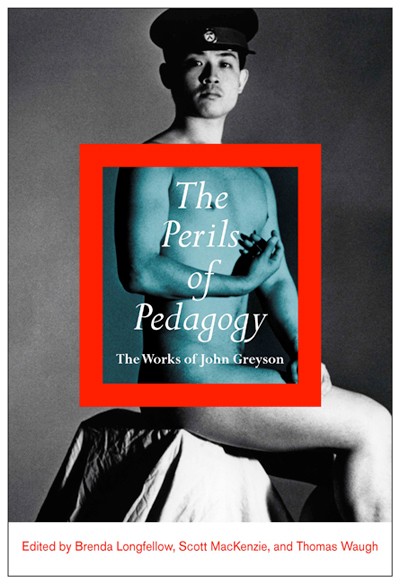
The Perils of Pedagogy edited by Thomas Waugh, Brenda Longfellow and Scott MacKenzie gives a brilliant overview of the oeuvre of John Greyson and how the filmmaker masterfully manipulates genre to raise questions about the state, sexuality and activism. 12 Such an all encompassing and detailed reflection has been largely lacking when it comes to other members of the Toronto new wave, especially Bruce McDonald. Both McDonald and Greyson early in their careers were considered guerrilla filmmakers and both have risen to become important Canadian auteurs. 13 Greyson first produced activist tapes while McDonald focused mostly on music and the road in his films to articulate a distinctly Canadian voice on Canadian identity. Both have directed episodes of the Canadian TV program Queer as Folk (1999-2000) and both directors have dabbled in mainstream cinema. What is most striking though, is how both these auteurs are masters of manipulating genre to make poignant statements about cultural identity, masculinity and art. Both Greyson and McDonald colonize genre in a self-reflexive way, appropriating genres and making them uniquely Canadian to reveal the complexity of identity and the influence of the rise of neo-liberalism and globalization. My analysis of McDonald’s first three films, Roadkill (1989), Highway 61 (1991), and Hard Core Logo (1996) will reflect on how the road movie, the mockumentary and musical are colonized and made to be self-reflexive to reveal the bleak reality of Canadian national identity. The Perils of Pedagogy and the work of Greyson will be central to the analysis of McDonald’s self-reflexive use of genre and the sombre statement that it makes about Canadian nationalism.
Paul McEwen in his book on Hard Core Logo notes that theorists should not limit the concept of Canadian national cinema to specific qualities seeing as that many Canadian directors are vastly different in their approach to art and cinema. The author marks that though different, all Canadian filmmakers are actively in dialogue with Canadian identity. 14 Despite the fact that Greyson has a distinctly queer Canadian identity it is a Canadian identity nonetheless and the fluidity in which Greyson colonizes genre is tremendously similar to that of McDonald. Christine Ramsay states, “speaking from and to several discursive worlds at once, Greyson draws together an eclectic audience of queers, Canadian culture aficionados, cultural activists, intellectuals steeped in critical thinking to participate in the making of new meaning”. 15 For this reason Greyson will be used as jumping off point to explore Bruce McDonald’s films.
Greyson uses humour in his films as a means of offsetting a conclusive position on complex political issues. This practice is used most poignantly in his films Fig Trees (2009), Making of Monsters (1991) and Urinal (1989) which self-reflexively blend documentary with humour and camp in order to delve into the depth and multiple perspectives of the particular issues and subvert a definitive conclusion. One of the most poignant ways this is done is by blurring the lines between documentary and fiction. Rooted in the traditions of John Grierson, Greyson subverts and oversteps Grierson through postmodernity. 16 Similar to Greyson, McDonald subverts the documentary form through self-reflexivity and the mockumentary sub-genre. It is through the self-reflexive use of mockumentary and humour in his films that McDonald reveals a fractured Canadian image that has been decentralized in the wake of globalization. McEwen in his book draws from Jane Roscoe and Craig Hight to help define mockumentary and states that it is highly reliant on self-reflexivity and critique. Self-reflexivity manifests itself in the conventions of the documentary that are exploited by a fictitious humorous narrative. The mockumentary also often critiques either the characters, the role of the media or the subject of the documentary itself. Both Roadkill and Hard Core Logo comment on the cinematic medium and the role of documentary filmmaker while at the same time revealing a fractured reality of Canadian identity.
The opening scene of Roadkill establishes the mockumentary and the humorous documentary format with a documentary like narration about the depopulation of the northern cotton tale rabbit. The narrator is excruciatingly slow and monotonous and it concludes by his stating that the reason for the depopulation of the rabbit is still unknown. At this moment feedback can be heard and a van barrels down the road toward the rabbit. On the hood of the van are the words ‘move or die.’ The rabbit and the van then seem to have a show down as the film cuts back and forth between the two. These first moments of the film comment immediately on the paltry and bland Canadian documentary and McDonald suggests that safe Canadian productions should be run over. Within both Roadkill and Hard Core Logo McDonald appears as a documentary filmmaker calling attention to the contrived nature of the medium.
Roadkill tells the story of Ramona (Valerie Buhagiar) an intern at a big booking agency that is sent to track down the Children of Paradise, a touring band that have not shown up to their recent bookings. Her boss is a white suit wearing corporate stereotype that perpetually screams at Ramona about the money they are losing. On the road Ramona encounters a whole slew of characters and personalities, one of which is McDonald himself. Bruce Shack or ‘the director’ meets Ramona once she is left stranded without money or clothes in the back ally of a diner. McDonald asks, “who do you work for?” and she states that her job is funded by a federal program. He then interrupts her and explains, “we work for the same people…Roy…” The emphasis firstly on the government funding of the arts then followed by its dismissal and emphasis of the corporate individual is remarkably telling of the state of the Canadian industry. Many productions in Canada manage to get funding for their productions but rarely make any money or have a significant impact on Canadian identity.
The emphasis on the dominance of corporate America is similarly articulated in the finale of the film. Once Ramona has assembled the band and they finally play, everyone in the bar is then gunned down by Roy. Ramona is the sole survivor and is ordered back to work the following day. Despite Canada’s funding of the arts the overwhelming dominance of the American corporate media is emphasized. The violence of the concluding scene reveals the hindered Canadian identity violently accosted by the American media.
Similarly in McDonald’s other features the corporate slick figures are treated with disdain. In Highway 61 an American man who thinks himself the devil preys off of people’s desires to literally buy people’s souls. He approaches individuals asking about their dreams and trades them tokens for them to sign a contract giving up their souls. Similar to Roy in Roadkill the man has slicked back hair and wears a suit. Though at the conclusion it is revealed that he is just delusional, the film seems to once again be alluding to the lure of American culture and how it easily manipulates Canadians.
Sociologist Reginal Biddy notes that many Canadian youths are becoming more and more right wing and that this is because “… People have a questionable sense of where they come from, few heroes and a passive acceptance of being inferior to the U.S. In lieu of having our own Canadian culture, the tendency has been to fill the void with American culture, contributing to the Americanization of Canadian life”. 17
Through the self-reflexivity of the mockumentary MacDonald reveals the dominance of corporate American culture, which is bleakly represented in Roadkill. Similarly the scene in which Russell (Don McKellar) discusses with Ramona his wanting to be a serial killer uses dark humour to articulate the state of the cinematic medium in Canada. Russell confesses to Ramona that he needs a profession so he has decided to become a serial killer. He then states, “It’s more of an American thing, traditionally, but it doesn’t have to be. It’s like everything else. There’s this colonial attitude about it, that if you want to make it you’ve got to go down to California or something…” The nonchalant tone of Russell makes the scene particularly ridiculous. Russell’s aspiration to become a serial killer is an obvious comment on Hollywood and the state of the industry in Canada. 18
In Hard Core Logo, the mockumentary genre is humorous while at the same time profoundly dark. The mockumentary is critical of the responsibility of the documentary team, led by McDonald, while similarly reveals the struggle between Canadian cultural identity and the U.S. The film follows Hard Core Logo, a punk band reunited for one last tour to support an injured punk icon. The two founding members of the band Billy Talent (Callum Keith Rennie) and Joe Dick (Hugh Dillion) are metaphors for conflicting elements of Canada’s cultural identity. Billy Talent, who is on the cusp of becoming an American rock and roll star with his American band Jenifur, returns to Canada to tour with his childhood friend Joe Dick. Dick is stuck in the past and is eerily nostalgic for his childhood. He does not want anything more than to play shows and despises Talent’s ‘selling out’. Talent and the other band members consistently portray him as out of touch with reality and a loser and it is later revealed that Dick stole money to fund the whole tour. The gap between Canada and the U.S’s industries is emphasized throughout the film in a darkly humorous way. At one point the cover of Spin magazine is shown with Jenifur on the cover. The other bands on the cover are The Headstones, Hugh Dillion’s real life band, and another fictitious Canadian band. This shot is humorous in that in the early nineties a Canadian band would be hard pressed to be featured on the cover of an American rock magazine, which emphasizes the exclusive nature of the American industry. 19
McEwen notes that, “the tension in Hard Core Logo between Joe’s and Billy’s versions of success is a tension about national identity. Choosing to stay in Canada is choosing to remain true to punk rock ideals, to focus on music and eschew the trappings of fame, if only because there are no trappings to be famous within the country”. 20 Near the end of the film Billy Talent decides to return to Jenifur and shares this information with McDonald. McDonald then informs Dick of the departure of the dear band mate, manipulating and toying with Dick. The film concludes with Dick tragically killing himself on camera, signalling the end of nostalgia and hope for the future. The self-reflexivity of the film keenly marks the contrived nature of the medium and notes the state of the industry. In true postmodern form the film delivers a nihilistic and hopeless ending.
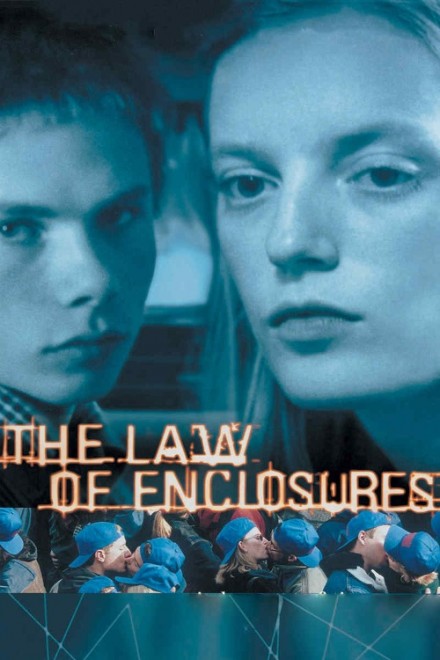
The Law of Enclosures
Though not a mockumentary, Highway 61 similarly uses satire and humour to reveal the complex relationship between Canada and the U.S. The film tells the story of a small town Barber Poky (Don McKellar) who is persuaded by a stranger to go on a road trip down south to deliver her dead brother to her family. The young woman is lying to Poky and plans on smuggling stolen drugs across the boarder in the coffin. The representations of the characters are stereotypical and over the top and throughout the journey the two run into a whole slew of wild and crazy American stereotypes. On the road the pair encounter rock stars who have lost all touch with reality, a single father hoping to bring back wholesome music with his family band and overzealous border guards. Throughout the road trip Poky sticks out as alien to his surroundings and an outsider; abandoned by his guide, Poky walks aimlessly through Louisiana until he is found once again. Using satire McDonald comments on how Canadian identity is submerged in American culture. Like Poky, Canadian identity is surrounded from all sides and is trying to find its way in a culture it does not relate to.
The road is a middle ground or ‘non-place’ where identities can be cultivated and homo-social relations explored. 21 Though Greyson does not explore the road genre in his work he is very much caught up in the collapsing of past and present and movement in order to comment on identity and homo-social relations. Films such as The Law of Enclosures (2000) and Urinal manipulate temporality to explore numerous issues of identity. 22 These films are constantly in motion, similar to the road genre, and take up the task of restructuring and appropriating history in a setting that is out of time or a ‘non-place’. Throughout Bruce McDonald’s trilogy the search for a solidified cultural identity is sought after and is never found. Instead the road emphasizes the lack of a cohesive cultural identity and the influence of American culture on Canada.
In Hard Core Logo the homo-social relationship of the two main characters is explored throughout the film. The relationship of Joe Dick and Billy Talent is subtly homosexual and is key to the film. Peter Robert Brown reveals that it is the betrayal of Talent and the incapability of Dick to properly articulate his homosexual feelings for him that ultimately leads to his suicide. 23 The character’s incapacity to articulate their feelings manifests itself in the form of aggressive behaviour and frequent homophobic slurs. The author interprets their behaviour as ‘queer’ and this in many ways reflects the aggressive homophobia and the contradictions of homo-social relationships in Canada in Greyson’s Making of Monsters. The fact that these characters are perpetually searching for belonging and hoping to find a place where they can articulate who they really are in many ways is representative of Canada’s lack of a definitive cultural identity. Wright posits that belonging is an essential part of developing a meaningful concept of citizenship. He goes on to state that the lack of any sense of belonging has largely lead to the decline in young peoples’ participation of the ‘national project’ and instead they participate in a hollowed out version citizenship. 24 In Hard Core Logo both Dick and Talent once belonged to the punk community but now as adults they are nostalgic for the past. This nostalgia represents the longing for the ‘golden age’ of Canadian nationalism of their youth. Wright posits that this is common for those who grew up during this ‘golden age’ of nationalism that was lost in the advent of globalisation. 25 Dick and Talent frequently reminisce about the good old days of their youth and Dick is perpetually fighting to remind Talent of a time when they belonged and thereby attempting to return to their teenage years.

Making of Monsters
Within Hard Core Logo the search for belonging is aligned with the geography of Canada. McEwen states that the map that charts the band’s tour anchors the group’s troubles in the Canadian landscape. 26 The progress of the band is clearly marked on a large map of Canada and as they venture further into the country they lose more of themselves as individuals. This culminates in an extended psychedelic drug trip that occurs mid film which fractures the narrative of mockumentary and alludes to it’s predecessor Easy Rider (1969). The film is similarly self-reflexive in its portrayal of the van on the road. A model of the vehicle is depicted on a never-ending model road, as a counter lists the kilometers, the liters of gas and the cigarettes smoked throughout their journey. This tally coupled with the obviously fake van and road is self-reflexive in that it emphasizes the contrived nature of the mockumentary. The repetition of the scene similarly references the genre binaries of the road movie and the iconic portrayal of the lines on the highway. Morris states that the iconography of the highway line, that is both broken and continuous, references the genre’s history while at the same time often holds narrative meaning. 27
Near the end of the film the repetitive shot of the model van is manipulated so that the highway lines become wavy. The wavy highway lines articulate the failing search for belonging and a solidified identity. Coupled with the search for identity and belonging, this reveals that at its core Hard Core Logo is a film preoccupied with the nostalgic search for a lost national identity and the pull of globalisation and American media.
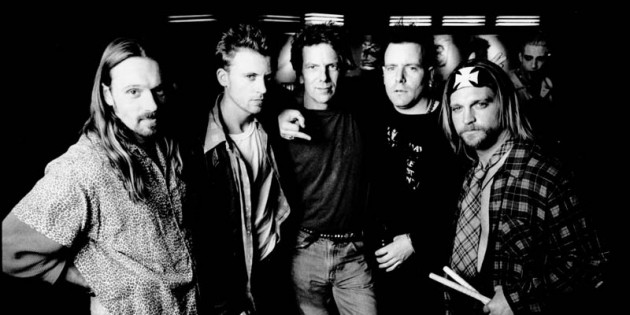
Hard Core Logo
Greyson’s colonizing of the musical genre is subversive in its appropriation and covering of American songs. Greyson’s ‘Karaoke’ of songs in his films is tremendously self-reflexive in that it calls the original song to mind while at the same time manipulating and reworking the lyrics so that they contain a pointed and subversive message. 28 Greyson himself describes his approach to the musical as, “Our aim was to take the fluffy, discredited genre of the movie musical and fill it up with the urgent take-no-prisoners content/aesthetics…” (301). Similarly McDonald in his films colonizes the musical and makes it an urgent, dark and highly performative genre that is uniquely Canadian but nonetheless heavily indebted to the U.S. McDonald in many ways hints at how Canadian music has carved out a small niche market for itself, though overwhelmed by American culture.
Susan Hayward in her essay, “Framing National Cinema” 29 states that nationalism is largely performative. 30 The fact that McDonald’s movies all culminate in musical performances that are uniquely Canadian is representative of the search for a purely Canadian nationalism. At the end of Roadkill Ramona reunites the group and they play their final show that concludes with their execution by Ray. In Highway 61 Pokey (Don McKellar) finally plays the trumpet in New Orleans. The anticipation of this performance has been built up throughout the film. In Hard Core Logo the struggle for Canadian identity is constant and throughout the film the band preforms in major Canadian cities to sparse audiences. The musical performance of Canadian nationalism is sparse and anti-climatic in McDonald’s films. Instead the more solidified and American symbols and icons dominate over the Canadian performances within his films.
In Wright’s essay on the decline of Canadian nationalism and the rise of the Canadian right, the author notes that sixty percent of young people who were asked about who they thought the greatest Canadian figure of all time was responded with “no one comes to mind”. 31 Instead many young people adopt American icons. American musical icons are similarly littered throughout McDonald’s films. References to American artists are rampant in McDonald’s trilogy. The filmmaker references Bob Dylan in Highway 61 and Alice Cooper amongst others in Roadkill. The cameos of Joey Ramone of The Ramones in Roadkill and Hard Core Logo and of Jello Biafra, lead singer of the Dead Kennedys, in Highway 61 similarly hints at the influence that American culture has on Canadian national identity. Joey Ramone in Hard Core Logo praises the fictitious punk legend Bucky Haight (Julian Richings) which subtly reveals that in order for a Canadian punk legend to be influential he needs to be introduced by an American punk legend. 32
Hayward in her essay posits that symbolically the female body in national cinema represents nationalism and colonization. The body and its exploitation and representation is often a metaphor for the nation and its cultural significance. 33 The most prominent female figure in the McDonald trilogy is Valerie Buhagiar. In Roadkill Buhagiar plays Ramona who is the muse of McDonald. Despite her self-discovery at the end of the film she returns to her corporate boss Roy. Buhagiar plays Jackie Bangs in Highway 61, an American roadie who manipulates Poky to embark on a road trip down south. Jackie is actively involved in the music industry, she is empowered, sexually liberated and dominates over the mild-mannered Poky. At one point within the film she even scolds Poky for being typically Canadian. Both Buhagiar’s roles once again hint at a fractured Canadian nationalism. Within Hard Core Logo the only female characters within the film are two roadside prostitutes that appear in a diner and a groupie that Talent was involved with back in the heyday of the band. The portrayal of women in McDonald’s trilogy similarly hints at lack of a symbolic representative of strong Canadian identity. Instead these figures are often written off as secondary, in the past or empowered by American nationalism.

Roadkill
When one reflects on the work of Canadian auteurs such as Greyson and McDonald and the ways they search for cultural identity it becomes apparent that Canadian films do not offer a unified Canadian nationalism. The cultural identities revealed are multicultural and multiple identities are explored throughout these films. While Greyson is not preoccupied with Canadian cultural identity, McDonald in his trilogy, directly addresses the search for a unified Canadian identity and its shortcomings. McEwen states that the falling short of Canadian identity is due to the long colonial history with the British and he posits that by the time the nation attempted to forge its own national image it was too late. The author marks how as a culture Canadians are now trying to formulate a singular identity but are too aware of the multiple perspectives, genders, races and classes to formulate singular national identity. 34 Wright agrees that the Canadian identity is fractured but instead blames globalisation for the lack of a unified national image. Wright states,
They have been trained in postmodern fashion to embrace diversity,to imagine their own identities as subjective, fluid and socially constructed, to be suspicious of “in-group versus out-group” distinctions, and to distrust reductionist notions like “national identity”. 35
Despite the reason, the duplicitous Canadian identity is one that eludes consistency and is largely nostalgic for the ‘golden age’ of Canadian nationalism. McDonald’s films also reveal the difficult struggle for national identity in light of the pervasive influence of the American media. Through the colonization of genres, McDonald in his first three films uses the road, mockumentary and the musical genre to reveal the complex and fractured state of the Canadian identity. Perhaps it is for this reason that most Canadian productions have no hope of making money and that American films take up ninety six percent of the market in Canada. With only two percent of films being screened in Canada actually being Canadian it seems like the only road to take for the industry is south. 36
Bibliography:
Abbott, Stacey. Celluloid vampires: life after death in the modern world. Austin: University of Texas Press, 2007.
Blake, Linnie. The Wounds of Nations: Horror Cinema, Historical Trauma and National Identity. Manchester: Manchester UP, 2008.
Brown, Peter Robert. ““Which Way You Goin’ Billy?”: Masculinity, Genre, and Self-Reflexivity In Hard Core Logo.” Canadian Journal of Film Studies Fall 2009, Vol. 18.Issue 2: pps. 87-103.
Hayward, Susan. “Framing National Cinema.” Nation & Cinema. Ed. Mette Hjort and Scott Mackenzie. London and New York: Routledge, 2000.
Longfellow, Brenda. “Ten Propositions on Operatic Subversions and the “Charge of the Real” in John Greyson’s Fig Trees.” The Perils of Pedagogy The Works of John Greyson. Ed. Brenda Longfellow, Scott MacKenzie, and Thomas Waugh. Montreal: McGill-Queen’s UP, 2013.
Morris, Christopher. “The Reflexivity of the Road Film.” Film Criticism Vol. 28. Fall 2003.
McEwan, Paul. Bruce McDonald’s Hard Core Logo. Toronto, Ont.: U of Toronto, 2011.
Trudeau, Pierre Elliott, Conversation With Canadians. Toronto: University of Toronto Press, 1972.
Waugh, Thomas. “Notes on Greyzone.” The Perils of Pedagogy the Works of John Greyson. Montreal: McGill-Queen’s UP, 2013.
Wise, Wyndham Take 1. Toronto:Ontario.1992.96.
Wright, Robert. “L’Etat, C’est Molson? Youth and the Decline of Canadian Nationalism.” Virtual Sovereignty: Nationalism, Culture and the Canadian Question. Canadian Scholars, 2004.
Notes
- Wright, Robert. “L’Etat, C’est Molson? Youth and the Decline of Canadian Nationalism.” Virtual Sovereignty: Nationalism, Culture and the Canadian Question. Canadian Scholars, 2004.153. ↩
- ibid., 153 ↩
- sex workers. ↩
- Trudeau, Pierre Eliot, Conversation With Canadians (Toronto: University of Toronto Press, 1972), 30. ↩
- Blake, Linnie. The Wounds of Nations: Horror Cinema, Historical Trauma and National Identity. Manchester: Manchester UP, 2008, 8. ↩
- Abbott, Stacey. Celluloid Vampires: life after death in the modern world. Austin: University of Texas Press, 2007, 174. ↩
- Wright, Robert. “L’Etat, C’est Molson? Youth and the Decline of Canadian Nationalism.” Virtual Sovereignty: Nationalism, Culture and the Canadian Question, Canadian Scholars, 2004, 156. ↩
- ibid., 187 ↩
- Wise, Wyndham Take 1. Toronto: Ontario, 1992, 96 ↩
- Waugh, Thomas. “Notes on Greyzone.” The Perils of Pedagogy the Works of John Greyson. Montreal: McGill-Queen’s UP, 2013.28. ↩
- Hayward, Susan. “Framing National Cinema.” Nation & Cinema. Ed. Mette Hjort and Scott Mackenzie. London and New York: Routledge, 2000, 96 ↩
- Waugh, Thomas. “Notes on Greyzone.” The Perils of Pedagogy the Works of John Greyson. Montreal: McGill-Queen’s UP, 2013, 30. ↩
- Ramsay, Christine. “Greyson, Grierson, Goddard, God: Reflections on the Cinema of John Greyson (2002).” The Perils of Pedagogy The Works of John Greyson. Ed. Brenda Longfellow, Scott MacKenzie, and Thomas Waugh. Montreal: McGill-Queen’s UP, 2013, 181. ↩
- McEwan, Paul. Bruce McDonald’s Hard Core Logo. Toronto [Ont.: U of Toronto, 2011, 15-16. ↩
- Ramsay, Christine. “Greyson, Grierson, Goddard, God: Reflections on the Cinema of John Greyson (2002).” The Perils of Pedagogy The Works of John Greyson. Ed. Brenda Longfellow, Scott MacKenzie, and Thomas Waugh. Montreal: McGill-Queen’s UP, 2013, 181. ↩
- Waugh, Thomas. “Notes on Greyzone.” The Perils of Pedagogy the Works of John Greyson. Montreal: McGill-Queen’s UP, 2013, 30. ↩
- Wright, Robert. “L’Etat, C’est Molson? Youth and the Decline of Canadian Nationalism.” Virtual Sovereignty: Nationalism, Culture and the Canadian Question. Canadian Scholars, 2004, 176. ↩
- McEwan, Paul. Bruce McDonald’s Hard Core Logo. Toronto [Ont.: U of Toronto, 2011, 13. ↩
- McEwan, Paul. Bruce McDonald’s Hard Core Logo. Toronto. Ont.: U of Toronto, 2011, 66. ↩
- Ibid., 71 ↩
- Morris, Christopher. “The Reflexivity of the Road Film.” Film Criticism Vol. 28. Fall 2003: p24-52, 89. ↩
- Champagne, John, Brenda Longfellow, Scott MacKenzie, and Thomas Waugh. “On the Uses and Disadvantages of History of the Other: AN Untimely Meditation (1995).” The Perils of Pedagogy The Works of John Greyson. Montreal: McGill-Queen’s UP, 2013. ↩
- Brown, Peter Robert. ““Which Way You Goin’ Billy?”: Masculinity, Genre, and Self-Reflexivity In Hard Core Logo.” Canadian Journal of Film Studies, Fall2009, Vol. 18. Issue 2. ↩
- Wright, Robert. “L’Etat, C’est Molson? Youth and the Decline of Canadian Nationalism.” Virtual Sovereignty: Nationalism, Culture and the Canadian Question. Canadian Scholars, 2004, 156. ↩
- Ibid., 155. ↩
- Wright, Robert. “L’Etat, C’est Molson? Youth and the Decline of Canadian Nationalism.” Virtual Sovereignty: Nationalism, Culture and the Canadian Question. Canadian Scholars, 2004, 68. ↩
- Morris, Christopher. “The Reflexivity of the Road Film.” Film Criticism Vol. 28. Fall 2003, 7. ↩
- Longfellow, Brenda. “Ten Propositions on Operatic Subversions and the “Charge of the Real” in John Greyson’s Fig Trees.” The Perils of Pedagogy The Works of John Greyson. Ed. Brenda Longfellow, Scott MacKenzie, and Thomas Waugh. Montreal: McGill-Queen’s UP, 2013.484 ↩
- Hayward, Susan. “Framing National Cinema.” Nation & Cinema. Ed. Mette Hjort and Scott Mackenzie. London and New York: Routledge, 2000.88. ↩
- Ibid., 98. ↩
- Wright, Robert. “L’Etat, C’est Molson? Youth and the Decline of Canadian Nationalism.” Virtual Sovereignty: Nationalism, Culture and the Canadian Question. Canadian Scholars, 2004. 177. ↩
- McEwan, Paul. Bruce McDonald’s Hard Core Logo. Toronto [Ont.: U of Toronto, 2011. 61. ↩
- Hayward, Susan. “Framing National Cinema.” Nation & Cinema. Ed. Mette Hjort and Scott Mackenzie. London and New York: Routledge, 2000.95. ↩
- McEwan, Paul. Bruce McDonald’s Hard Core Logo. Toronto [Ont.: U of Toronto, 2011.17. ↩
- Wright, Robert. “L’Etat, C’est Molson? Youth and the Decline of Canadian Nationalism.” Virtual Sovereignty: Nationalism, Culture and the Canadian Question. Canadian Scholars, 2004, 153. ↩
- McEwan, Paul. Bruce McDonald’s Hard Core Logo. Toronto [Ont.: U of Toronto, 2011. 73. ↩



